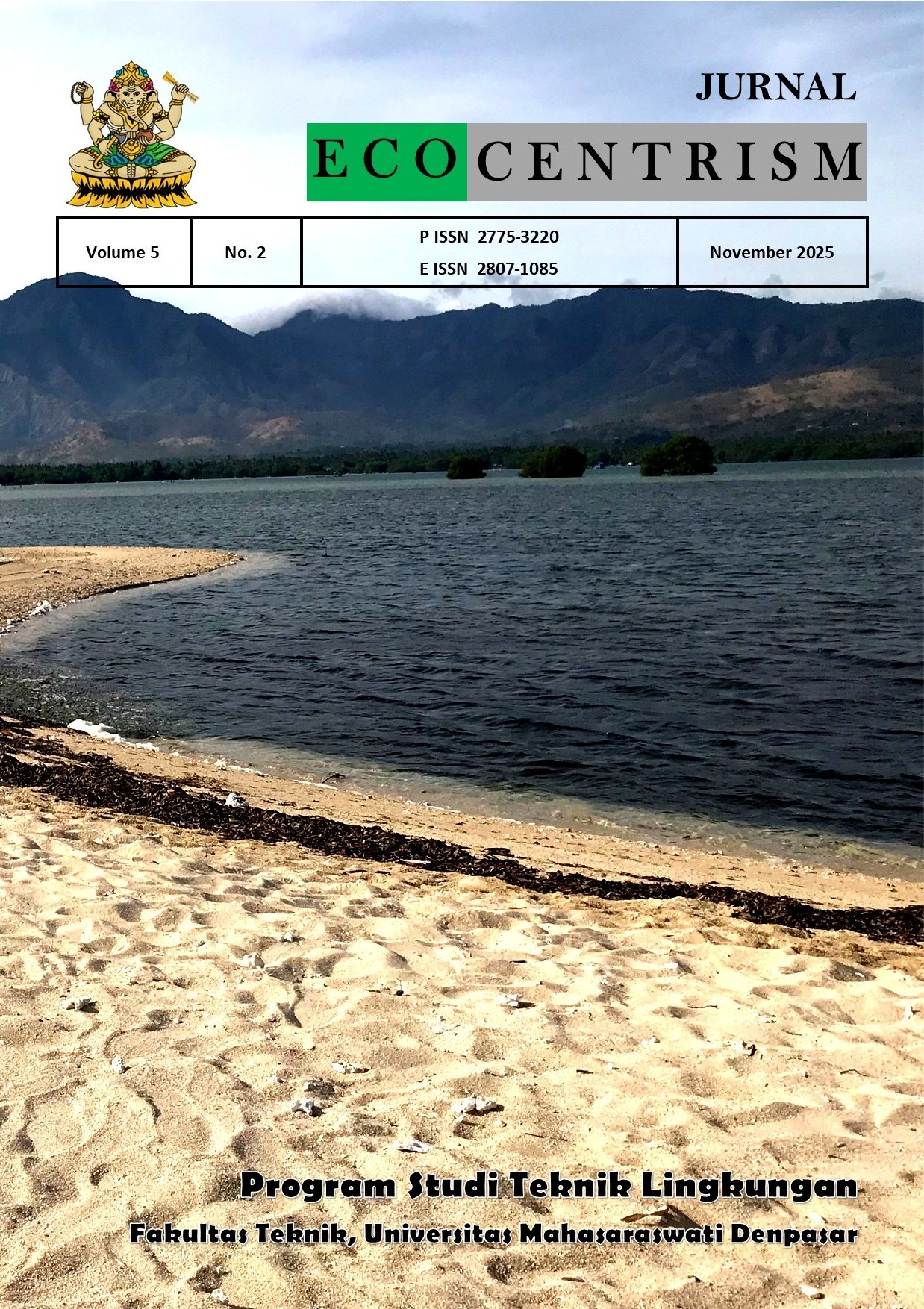POTENSI PEMANFAATAN LIMBAH PADAT KELAPA SAWIT SEBAGAI UPAYA MENINGKATKAN EFISIENSI ENERGI DI PABRIK KELAPA SAWIT
DOI:
https://doi.org/10.36733/jeco.v5i2.12914Keywords:
compost, solid waste, waste management, palm fiber, palm kernel shellAbstract
The palm oil industry has a significant impact on the regional and national economy, generating employment, especially for farmers. Crude palm oil (CPO) can be processed into edible oil, cosmetics, and biofuels, making it a strategic commodity in global trade. However, this industry also produces abundant solid and liquid waste, such as shells, fibers, and empty fruit bunches. Factory waste must be managed and processed to prevent environmental pollution. Poor waste management can lead to various environmental problems, necessitating effective and sustainable management strategies. This type of solid waste has the potential to be used as an alternative energy source and raw material for value-added products. The objective was to determine the utilization of palm oil solid waste and its percentage, as an effort to optimize industrial waste management. The methods used included direct observation of the processing and utilization of solid waste at the factory, collection of production data, and a review of relevant literature. The results showed that empty fruit bunches are used as compost and mulch in plantations, shells are used as boiler fuel to generate steam energy, and fiber is used as supplementary fuel. According to the literature review, this solid waste still has potential for further development, such as the production of briquettes, pellets, and biomass-based activated carbon. Optimizing the utilization of palm oil solid waste can increase the energy efficiency of factories and reduce the volume of waste.
References
Adu, M.O., Atia, K., Arthur, E. et al. (2022). The use of oil palm empty fruit bunches as a soil amendmentto improve growth and yield of crops. A meta-analysis. Agron. Sustain. Dev. 42, 13. https://doi.org/10.1007/s13593-022-00753-z
Bintang, M., Gunawan, S., & Yuniasih, B. (2024). Teknik Pengaplikasian Tandan Kosong pada Perkebunan Kelapa Sawit di PT Karya Bakti Agro Sejahtera Provinsi Kalimantan Barat. AGROFORETECH, 2(1), 9–15. https://jurnal.instiperjogja.ac.id/index.php/JOM/article/view/1044
Egbe Terence Awoh, Joseph Kiplagat, Stephen K. Kimutai, Achisa C. Mecha. (2023). Current trends in palm oil waste management: A comparative review of Cameroon and Malaysia. Heliyon, 9(11), e21410, ISSN 2405-8440, https://doi.org/10.1016/j.heliyon.2023.e21410
Febrina, D., Pratama, R., & Febriyanti, R. (2020). Pengaruh Jenis Pengolahan Dan Lama Pemeraman Terhadap Kandungan Fraksi Serat Pelepah Kelapa Sawit. Jurnal Ilmiah Peternakan Terpadu, 8(2), 60. https://doi.org/10.23960/jipt.v8i2.p60-65
Gunawan, H. C., Mungok, C. D., & Lestyowati, Y. (2018). Pemanfaatan Abu Boiler Cangkang Kelapa Sawit Sebagai Bahan Tambah Pada Campuran Beton. JeLAST : Jurnal PWK, Laut, Sipil, Tambang, 5(2), 1-9. https://doi.org/10.26418/jelast.v5i2.26395
Juan Camilo Barrera Hernandez, Alexis Sagastume Gutierrez, Nidia Elizabeth Ramírez-Contreras, Juan J. Cabello Eras, Jesús Alberto García-Nunez, Osmar Ricardo Barrera Agudelo, Electo Eduardo Silva Lora. (2024). Biomass-based energy potential from the oil palm agroindustry in Colombia: A path to low carbon energy transition. Journal of Cleaner Production, 449, 141808, ISSN 0959-6526, https://doi.org/10.1016/j.jclepro.2024.141808
Khoirul Solehah binti Abdul Rahim, Alinda binti Samsuri, Siti Hasnawati binti Jamal, Siti Aminah binti Mohd Nor, Siti Nor Ain binti Rusly, Hafizah binti Ariff, Nur Shazwani binti Abdul Latif. (2024). Redefining biofuels: Investigating oil palm biomass as a promising cellulose feedstock for nitrocellulose-based propellant production. Defence Technology, 37, 111-132, ISSN 2214-9147, https://doi.org/10.1016/j.dt.2023.09.014
Kurniawan, E., Ginting, Z., & Dewi, R. (2022). Dahliana, Kurniawan, E., Ginting, Z., & Dewi, R. (2022). Pemanfaatan limbah serabut kelapa sawit (elaeis guineensis jacg.) Sebagai sumber energi alternatif dalam pembuatan biopelet. Chemical Engineering Journal Storage, 2 (2), 11–24. https://doi.org/10.29103/cejs.v2i2.6013
Lacour M. Ayompe, M. Schaafsma, Benis N. Egoh. (2021). Towards sustainable palm oil production: The positive and negative impacts on ecosystem services and human wellbeing. Journal of Cleaner Production, 278, 123914, ISSN 0959-6526, https://doi.org/10.1016/j.jclepro.2020.123914
Lubis, A. F. A., Effendi, Z., & Guntoro, G. (2022). Pembuatan Papan Partikel Dengan Menggunakan Bahan Baku Tandan Kosong Kelapa Sawit Dan Perekat Resin. Jurnal Agro Fabrica, 4(1), 1–9. https://doi.org/10.47199/jaf.v4i1.176
Marfitania, T., Yunianto, Hariyanto, Saragih, K. P., & Januarti, R. (2024). Sintesis Zeolit-Karbon Aktif Berbasis Abu Boiler Pabrik Kelapa Sawit Sebagai Adsorben Asam Lemak Bebas dan Karoten pada Crude Palm Oil. Jurnal Syntax Admiration, 5(1), 220–230. https://doi.org/10.46799/jsa.v5i1.978
Mujahid Tabassum, Md. Bazlul Mobin Siddique, Hadi Nabipour Afrouzi, Saad Bin Abdul Kashem. (2025). A Feasibility Study of Renewable Energy Generation from Palm Oil Waste in Malaysia. Energy Engineering, 122(9), 3433-3457, ISSN 0199-8595, https://doi.org/10.32604/ee.2025.065955
Okalia, D., Nopsagiarti, T., & Ezward, C. (2018). Pengaruh Ukuran Cacahan Tandan Kosong Kelapa Sawit Terhadap Karakteristik Fisik Kompos Tritankos (Triko Tandan Kosong). Jurnal Agroqua: Media Informasi Agronomi dan Budidaya Perairan, 16(2), 132. https://doi.org/10.32663/ja.v16i2.523
Peter Oosterveer. (2015). Promoting sustainable palm oil: viewed from a global networks and flows perspective, Journal of Cleaner Production, 107, 146-153, ISSN 0959-6526, https://doi.org/10.1016/j.jclepro.2014.01.019
Sharma U, Sharma D, Kumar A, Bansal T, Agarwal A, Kumar S, Hussian A, Kamyab H, Haq M. (2024). Utilization of refuse-derived fuel in industrial applications: Insights from Uttar Pradesh, India. Heliyon, 11(1), 41336. https://doi.org/10.1016/j.heliyon.2024.e41336
Siswanto, J. E. (2020). Analisis Limbah Kelapa Sawit Sebagai Bahan Bakar Boiler dengan Menggunakan Variasi Campuran Antara Fiber dan Cangkang Buah Sawit. Journal of Electrical Power Control and Automation (JEPCA), 3(1), 22. https://doi.org/10.33087/jepca.v3i1.35
Siti Naderah Sulin, Mohd Noriznan Mokhtar, Azhari Samsu Baharuddin, Mohd Afandi P. Mohammed. (2025). Simulation and techno-economic evaluation of integrated palm oil mill processes for advancing a circular economy. Cleaner Environmental Systems, 19, 100323, ISSN 2666-7894, https://doi.org/10.1016/j.cesys.2025.100323
Vitri, G., & Hazmal Herman. (2019). Pemanfaatan Limbah Kelapa Sawit Sebagai Material Tambahan Beton. Jurnal Teknik Sipil ITP, 6(2), 78–87. https://doi.org/10.21063/jts.2019.v602.06
W.A. Wan Mahari, et al. (2021). Valorization of municipal wastes using co-pyrolysis for green energy production, energy security, and environmental sustainability: A review. Chem. Eng. J. 421 (P1), 129749, https://doi.org/10.1016/j.cej.2021.129749
Yanti, R. N., Ratnaningsih, A. T., & Ikhsani, H. (2022). Pembuatan Bio-briket Dari Produk Biochar Cangkang Kelapa Sawit Sebagai Sumber Energi Alternatif. J. Ilmu Pertanian, 19(1), 11–18. https://doi.org/10.31849/jip.v19i1.7815
Yerizam, M., Dewi, E., Hasan, A., Ridho Triadi, M., Fia Atindu, N., & Rizky Amelia, S. (2021). Pemanfaatan Tandan Kosong Kelapa Sawit Dalam Proses Pembuatan Pupuk Organik Padat. Jurnal Pendidikan dan Teknologi Indonesia, 1(11), 461-464. https://doi.org/10.52436/1.jpti.121


